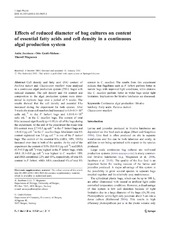Effects of reduced diameter of bag cultures on content of essential fatty acids and cell density in a continuous algal production system
Peer reviewed, Journal article
Published version
Permanent lenke
https://hdl.handle.net/1956/5444Utgivelsesdato
2011-02-16Metadata
Vis full innførselSamlinger
Originalversjon
Journal of Applied Phycology 24(1): 109-116 https://doi.org/10.1007/s10811-011-9655-6Sammendrag
Cell density and fatty acid (FA) content of Pavlova lutheri and Chaetoceros muelleri were analysed in a continuous algal production system (250-L bags) with reduced diameter. The cell density and FA content and composition in the algal production system were determined in replicate bags over a period of 5 weeks. The results showed that the cell density and essential FAs increased during the experiment for both species. After 5 weeks the mean cell numbers had increased to 6.0±0.3×106 cells mL−1 in the P. lutheri bags and 6.0±0.4×106 cells mL−1 in the C. muelleri bags. The content of total FAs increased significantly (p<0.05) in all of the bags during the experiment. At the end of the experiment the mean total FA content were 2.7±0.3 pg cell−1 in the P. lutheri bags and 1.8±0.1 pg cell−1 in the C. muelleri bags. Maximum total FA content registered was 3.0 pg cell−1 in one of the P. lutheri bags. The content of the essential FAs (ARA, EPA, DHA) increased over time in both of the species. At the end of the experiment the content of EPA (0.6±0.1 pg cell−1) and DHA (0.3±0.0 pg cell−1) were highest in the P. lutheri bags, while ARA (0.1±0.0 pg cell−1) was highest in C. muelleri. EPA and DHA constituted 22% and 11%, respectively, of total FA content in P. lutheri, while ARA constituted 6% of total FA content in C. muelleri. The results from this experiment indicate that flagellates such as P. lutheri perform better in narrow bags with improved light conditions, while diatoms like C. muelleri perform better in wider bags under light limitation. Implications for bivalve hatcheries are discussed.

